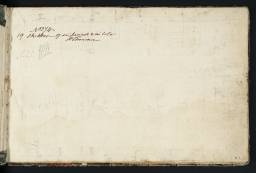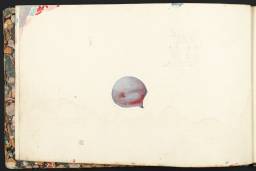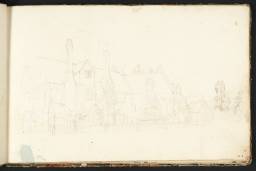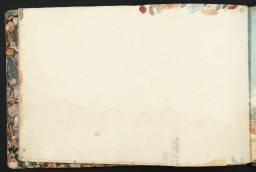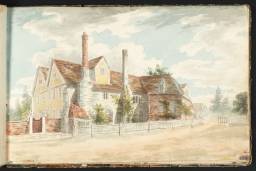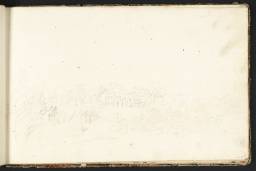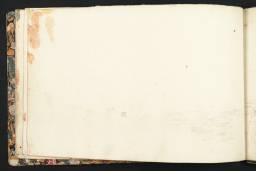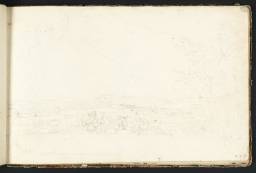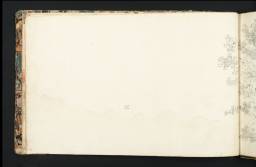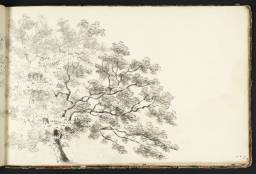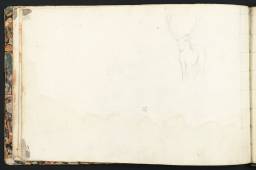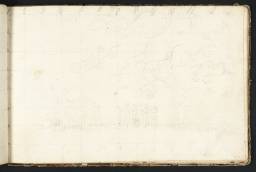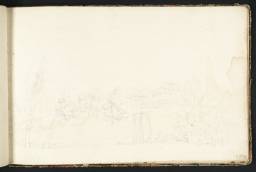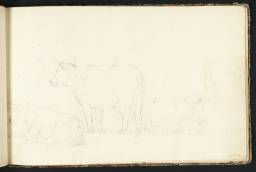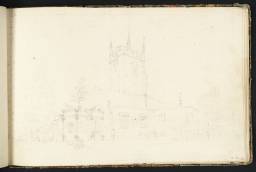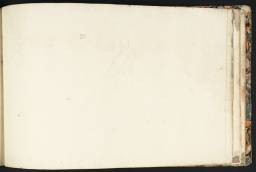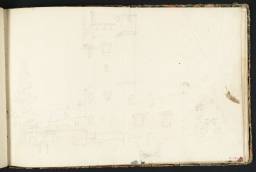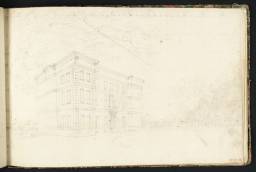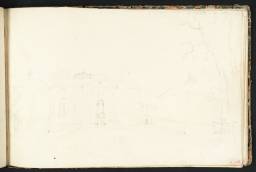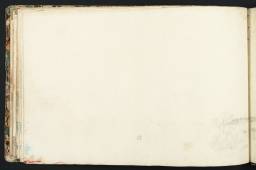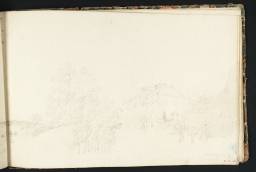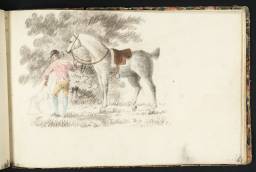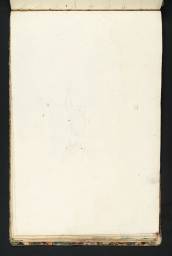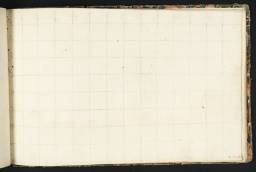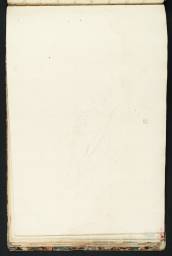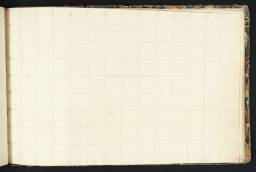Turner Bequest II 1–26a
Sketchbook bound in marbled paper boards; both covers are made up of scraps of paper pasted onto card; the marbled paper is folded over these so that both inside covers are partly obscured by it; Finberg conjectures that the book was home-made.
26 leaves of white laid paper, the upper and lower edges machine-cut; the outer edges seem to be hand-trimmed; the stitching has been renewed; folio 26 (D000440) has been tipped in; watermarked ‘I Taylor’, or fleur-de-lys and shield with ‘GR’; page size 160 x 249 mm
Inscribed by Turner in ink ‘76 Oxford’ on label on spine (D40737)
Stamped in black ‘II’ top right of front cover
Stamped in black ‘II’ and inscribed by A.M. Hind in pencil ‘The stain on lower part of | leaves caused by the flood of January 1928, | A.M.H.’ top left inside front cover
Numbered 274 as part of the Turner Schedule, and endorsed by the Executors of the Turner Bequest, Henry Scott Trimmer, Charles Turner, and John Prescott Knight and Charles Lock Eastlake in ink ‘No 274 – | 19 sketches – 17 in pencil, 2 in colour | H. S. Trimmer’ and in pencil ‘C. L. E’. and ‘JPK’ on folio 1 recto (D00010)
Finberg records Ruskin’s inscription on the wrapper: ‘274. Earliest book: of original sketches of the 1790 subjects. Most interesting’
26 leaves of white laid paper, the upper and lower edges machine-cut; the outer edges seem to be hand-trimmed; the stitching has been renewed; folio 26 (D000440) has been tipped in; watermarked ‘I Taylor’, or fleur-de-lys and shield with ‘GR’; page size 160 x 249 mm
Inscribed by Turner in ink ‘76 Oxford’ on label on spine (D40737)
Stamped in black ‘II’ top right of front cover
Stamped in black ‘II’ and inscribed by A.M. Hind in pencil ‘The stain on lower part of | leaves caused by the flood of January 1928, | A.M.H.’ top left inside front cover
Numbered 274 as part of the Turner Schedule, and endorsed by the Executors of the Turner Bequest, Henry Scott Trimmer, Charles Turner, and John Prescott Knight and Charles Lock Eastlake in ink ‘No 274 – | 19 sketches – 17 in pencil, 2 in colour | H. S. Trimmer’ and in pencil ‘C. L. E’. and ‘JPK’ on folio 1 recto (D00010)
Finberg records Ruskin’s inscription on the wrapper: ‘274. Earliest book: of original sketches of the 1790 subjects. Most interesting’
Accepted by the nation as part of the Turner Bequest 1856
References
As Finberg suggests, this book was probably in use during a stay with Turner’s uncle, the butcher Joseph Mallord William Marshall, at Sunningwell in 1789, though some subjects (folios 21 recto and 22 recto; D00038, D00040) indicate that it was also used nearer to London, and in London itself. With its drawings of Sunningwell Church, Nuneham Courtenay, Radley Hall, Isleworth Church and Lambeth Palace the book demonstrates that Turner’s main concern at this early date was already with architectural topography. The studies on folios 6 recto and 10 recto (D00016, D00022) would appear to be preparatory for the finished view of Nuneham Courtney (Tate D00002; Turner Bequest I B), which is dated 1787. But in view of the probably later dating of the sketchbook as a whole these may be subsequent sketches on the spot of a subject first copied from a print. A closer correspondence is that between the view of Oxford from the Abingdon Road on folios 6 verso–7 recto (D40739, D00017) and the finished watercolour of the same subject, dated 1789 (Tate D00046; Turner Bequest III A). Finished watercolour views of Radley Hall, also from 1789, are Tate D00048 and D00049 (Turner Bequest III C, D).
The tree, animal and figure studies that occur on folios 5 recto, 8 recto, 11 recto, 17 recto and 19 recto (D00015, D00019, D00023, D00031, D00035) should all probably be seen as essays in the depiction of ‘staffage’ for such views, as the drawing of a boat on folio 21 verso (D00039) evidently is. Other figure studies indicate an interest in historical and other subject pictures, perhaps seen in the houses he drew; though some may be shadowy ideas for pictures of Turner’s own invention. There is one copy of a landscape by another artist, on folio 24 recto (D00042). A comparable range of interests is to be found in the Princeton sketchbook of a year or so later, in the collection of Princeton University Art Gallery.1
Technical notes
How to cite
Andrew Wilton, ‘Oxford sketchbook c.1789’, sketchbook, April 2012, in David Blayney Brown (ed.), J.M.W. Turner: Sketchbooks, Drawings and Watercolours, Tate Research Publication, December 2012, https://www

